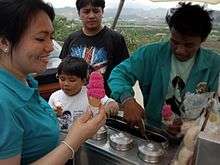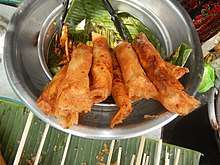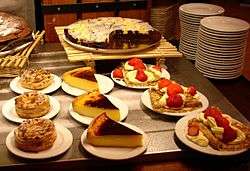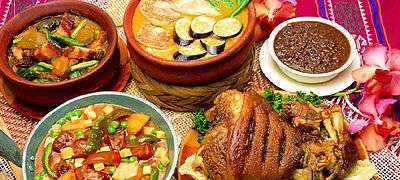List of Philippine desserts
This is a list of Filipino desserts. Filipino cuisine consists of the food, preparation methods and eating customs found in the Philippines. The style of cooking and the food associated with it have evolved over many centuries from its Austronesian origins to a mixed cuisine of Malay, Spanish, Chinese, and American influences adapted to indigenous ingredients and the local palate.[1]
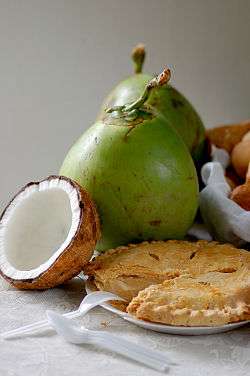
Buko pie and ingredients
Philippine desserts
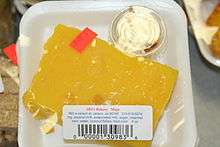
Corn maja blanca
- Alfajor
- Apas
- Bakpia
- Banana cue
- Baye baye
- Belekoy
- Bibingka
- Biko
- Binatog
- Biskotso
- Brazo de Mercedes - a rolled meringue cake filled with a lemon-flavoured custard
- Bukayo
- Buko pie – a traditional Filipino baked young-coconut (malauhog) custard pie. It is considered a specialty in the city of San Pablo City, Laguna located on the island of Luzon[2]
- Camote cue
- Cascaron
- Caycay
- Crema de fruta
- Cassava cake
- Dodol
- Espasol
- Ginanggang
- Ginataan
- Guinomis
- Gulaman
- Halo-halo
- Inipit
- Kalamay
- Kutsinta
- Latik
- Leche flan
- Maíz con hielo
- Maja blanca
- Mango float
- Maruya
- Nata de coco
- Otap
- Palitaw
- Pastillas
- Piaya
- Pitsi-pitsî
- Polvorón
- Roscas
- Sans rival
- Sapin-sapin
- Silvana
- Sorbetes – the traditional variation of ice cream made in the Philippines, it is uniquely made from coconut milk, unlike other iced desserts that are made from animal milk.
- Suman
- Turón
- Ube ice cream
gollark: I mean, loads of major buildings have been made with it, so it would be extremely triskaidecagonal if they banned it *now*.
gollark: You should re-ask.
gollark: Or was when I asked... last year?
gollark: No, it's allowed.
gollark: But you can easily autoconstruct them with turtles or schematica.
References
| Wikimedia Commons has media related to Desserts of the Philippines. |
- Alejandro, Reynaldo (1985). The Filippino cookbook. New York, New York: Penguin. pp. 12–14. ISBN 978-0-399-51144-8. Retrieved June 30, 2011.
Civitello, Linda (2011). Cuisine and Culture: A History of Food and People. John Wiley and Sons. p. 263. ISBN 978-1-118-09875-2. Retrieved June 30, 2011.Just as Filipino people are part Malay, Chinese and Spanish, so is the cuisine of their seven-thousand-island nation
Philippines Country Study Guide. Int'l Business Publications. 2007. p. 111. ISBN 978-1-4330-3970-6. Retrieved June 30, 2011.Throughout the centuries, the islands have incorporated the cuisine of the early Malay settlers, Arab and Chinese traders, and Spanish and American colonizers along with other Oriental and Occidental accent and flavors.
"Philippine Cuisine." Archived June 16, 2011, at the Wayback Machine Balitapinoy.net Archived July 23, 2011, at the Wayback Machine. Accessed July 2011.
Morgolis, Jason (February 6, 2014). "Why is it so hard to find a good Filipino restaurant?". Public Radio International. Retrieved December 17, 2014.Philippine food has Chinese, Malaysian, Spanish and American influences — all cultures that have shaped the Philippines.
- "Pilgrimage for pies!". Flexicover. Retrieved April 3, 2014.
This article is issued from Wikipedia. The text is licensed under Creative Commons - Attribution - Sharealike. Additional terms may apply for the media files.
_puff_pastry.jpg)
